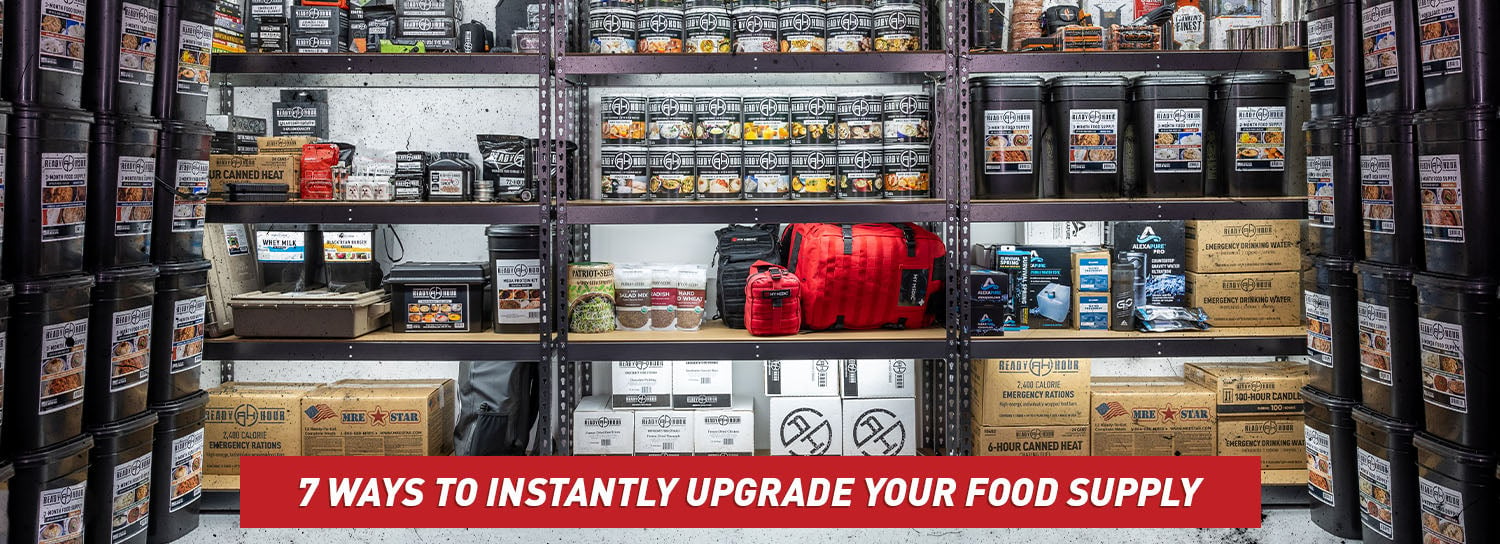
Spring has sprung, and there’s no better time than now to evaluate your emergency food supply—and upgrade it.
With what’s going on in our country and the rest of the world, it’s time to take stock and make sure your family is prepared for whatever happens next.
Do you have far more than the recommended three-day supply?
One natural disaster can easily knock out power for more than three days. The amount of emergency food you need grows even higher when you consider preparing for a potential cyberattack on the grid.
Here are seven ways to upgrade your food supply.
1. You Need More Protein

If your emergency food supply is primarily made up of non-perishable canned goods, we’re going to bet that means you’re seriously lacking in protein.
This is a problem. A huge problem.
Your body needs protein—especially in emergencies!
Easy Upgrade: My Patriot Supply offers a wide variety of long-term emergency food kits packed with meat and protein. You can quickly boost your food supply with the Mega Protein Kit with Real Meat (1 bucket of 72 servings) or the Protein Builder Case Pack (96 servings).
2. Don’t Overlook Your Greens
Greens are often overlooked for emergency stockpiles because we know we can’t adequately store fresh vegetables.
But vegetables are essential to staying healthy and strong during a disaster situation.
Fortunately, there are different ways to ensure your family gets the much-needed nutritional value from greens, such as growing your own and stocking up on freeze-dried vegetables.
Easy Upgrade: Ready Hour’s special freeze-dried fruits and vegetables are designed to taste great for up to 25 years. Eat them on their own or add them to soups and other dishes for extra flavor. Get an easy upgrade with the Veggie Case Pack (184 servings) or the Fruit, Veggie, & Snack Mix (122 servings). Start growing your own with Sprouting Seeds and Microgreens.
3. Upgrade Shelf Life
Many falsely believe that having non-perishable foods in their pantries means they are covered, should disaster strike.
But, according to the USDA, “Canned goods will last for years, as long as the can itself is in good condition (no rust, dents, or swelling). Packaged foods (cereal, pasta, cookies) will be safe past the 'best by' date, although they may eventually become stale or develop an off flavor.”
Sure, you can eat this food; but it will lose its normal taste over time.
Plus, there is also the risk of damaged cans causing issues like botulism.
Instead of stocking up on cheap “emergency” staples from the grocery store, stock up on long-term emergency food from the experts.
Easy Upgrade: My Patriot Supply offers short-term emergency food kits for three days to one month that average over 2,000 calories a day and last up to 25 years in storage. They also offer long-term emergency food kits designed to feed you for three months to one year.
Their 4-Week Emergency Food Supply contains foods like creamy stroganoff, southwest rice, and honey wheat bread. Their 3-Month Emergency Food Supply contains more than 22 food varieties, including spaghetti, mashed potatoes, and pancakes.
4. Double Your Water
Experts recommend you store at least one gallon of water per person per day. This should be enough for drinking, cooking, hygiene, and more.
So, a family of four would require twelve gallons of water for three days.
But as we’ve mentioned before, three days’ worth of any emergency supply is simply not enough. You must double your water.
How do you store this much water?
You invest in water storage solutions, and you purchase water filtration tools to enable your family to continue getting clean water when your supply runs dry.
Easy Upgrade: Invest in storage-ready Emergency Water Pouches by Ready Hour, as well as a Water Storage Kit that contains an emergency water bank, a five-gallon collapsible water container, and chlorine dioxide water treatment drops.
5. Stock Up on Heirloom Seeds
It’s not enough to just have a pantry—or even a bigger bunker—stocked with long-term emergency food.
When the worst-case scenario comes, you’ll need to have the means to continue to produce food after your supply runs out. (Because eventually, it will.)
Even if a long-term disaster doesn’t last forever, it’s important to be able to grow your own food to ensure you can be self-sufficient.
Easy Upgrade: We can’t emphasize enough the value of heirloom seeds over other seeds. If you plan to live self-sufficiently, you must grow your own food. Get started with the Survival Seed Vault.
6. Don’t Forget Comfort Foods and Drinks
One of the common mistakes people make when buying emergency food is they forget about what they actually like to eat.
When disaster strikes, you will want your favorite comfort foods and drinks.
People don’t think about stocking up on drinks like coffee, but you’ll be really thankful you did.
You might feel silly adding sweets to your emergency stash, but imagine how much better you—and your children—will feel when you enjoy a delicious chocolate pudding reminiscent of home when everything else in the world feels crazy.
Easy Upgrade: Add some comfort foods and drinks to your supply with the Breakfast Favorites #10 Can Food Pack that includes our orange energy drink mix, pancake mix, breakfast muffins, freeze-dried sliced strawberries, strawberry-flavored creamy wheat, and banana chips.
7. Make Sure You Have Emergency Cooking Utensils
One of the major selling points for Ready Hour’s long-term emergency food is the ability to cook flavorful, nutritious meals using only water and heat.
While these emergency foods require limited ingredients, you still need cooking utensils, such as pots and pans, to take those meals from the package to the table.
Now is the time to add a set of camping pots and pans to your emergency food pantry.
Easy Upgrade: Purchase the inexpensive Stainless Steel Mess Cooking Kit by Ready Hour.
Start upgrading your food supply, friends.
In liberty,
Elizabeth Anderson
Preparedness Advisor, My Patriot Supply




